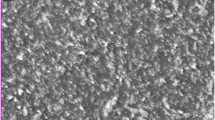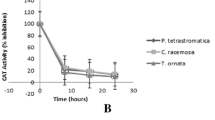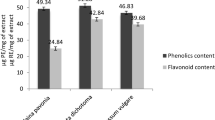Abstract
The current study was to investigate the gas chromatography/mass spectrometry, antioxidant, anticancer and antibacterial properties of red algae Laurencia caspica extract. The antioxidant capacity and total phenolic content of algae extract were measured utilizing DPPH scavenging assay and Folin–Ciocalteu procedure, respectively. Cell viability was measured using MTT assay against breast cancer T47D and HEK293 cells. Real-time PCR was used for measurement of gene expression. Flow cytometry was used for detecting of apoptosis in cells. Chemical analysis of L. caspica extract showed 22 most abundant components, and the most dominant compounds were Dodecane (17.33%), Undecane (6.616%) and Dodecane, 2, 6,11-trimethyl (5.483%). The real-time PCR results demonstrated dramatic elevation of mRNA levels of Nm23 in T47D cells. The Annexin V/PI staining showed that the L. caspica extract significantly increased apoptosis pathway in T47D cancer cell line. Moreover, antibacterial activity against pathogenic bacterial was evaluated. It seems that L. caspica has favorable resource with strong biomedical properties. So, further investigations were suggested to be carried out in cosmetics industries and food pharmaceutical.





Similar content being viewed by others
References
Antolovich M, Prenzler PD, Patsalides E, McDonald S, Robards K (2002) Methods for testing antioxidant activity. Analyst 127:183–198
Bazzaz BSF, Khajehkaramadian M, Shokooheizadeh HR (2005) In vitro antibacterial activity of Rheum ribes extract obtained from various plant parts against clinical isolates of gram negative pathogens. Iran J Pharm Res 2:87–91
Bevilacqua G, Sobel ME, Liotta LA, Steeg PS (1989) Association of low nm23 RNA levels in human primary infiltrating ductal breast carcinomas with lymph nodal involvement and other histopathological indicators of high metastatic potential. Cancer Res 49:5185–5190
Bozdogan O, Yulug G, Vargel I, Cavusoglu T, Karabulut A, Karahan G (2015) Differential expression pattern of metastasis suppressor proteins in basal cell carcinoma. Int J Dermatol 54:905–915
Buxton IL, Yokdang N (2011) Extracellular Nm23 signaling in breast cancer: incommodus verum. Cancers 3:2844–2857
Crews P, Selover SJ (1986) Comparison the sesquiterpenes from the seaweed Laurencia pacifica and its epiphyte Erythrocystis saccata. Phytochemistry 25:1847–1852
Demirel Z, Yilmaz-Koz FF, Karabay-Yavasoglu NU, Ozdemir G, Sukata A (2011) Antimicrobial and antioxidant activities of solvent extracts and the essential oil composition of Laurencia obtusa and Laurencia obtusa var. pyramidata. Rom Biotech Lett 16:5927–5936
Hay ME (2009) Marine chemical ecology: chemical signals and cues structure marine populations, communities, and ecosystems. Annu Rev Mar Sci 1:193–212
Howlett AR, Petersen OW, Steeg PS, Bissel MJ, Steeg PS (1994) A novel function for the nm23-Hl gene: overexpression in human breast carcinoma cells leads to the formation of basement membrane and growth arrest. J Natl Cancer Inst 86:1838–1844
Jung H, Seong HA, Ha H (2007) NM23-H1 tumor Suppressor and its interacting partner STRAP activate p53 function. J Biol Chem 282:35293–35307
Lin KH, Lin YW, Lee HF, Liu WL, Chen ST, Chang KS, Cheng SY (1995) Increased invasive activity of human hepatocellular carcinoma cells is associated with an overexpression of thyroid hormone beta 1 nuclear receptor and low expression of the anti-metastatic nm23 gene. Cancer Lett 98:89–95
Marinho-Soriano E, Fonseca PC, Carneiro MA, Moreira WSC (2006) Seasonal variation in the chemical composition of two tropical seaweeds. Bioresour Technol 97:2402–2406
Masuda M, Kawaguchi S, Abe T, Kawamoto T, Suzuki M (2002) Additional analysis of chemical diversity of the red algal genus Laurencia (Rhodomelaceae) from Japan. Phycol Res 50:135–144
Mohammadi M, Tajik H, Hajeb P (2013) Nutritional composition of seaweeds from the northern Persian Gulf. Iran J Fish Sci 12:232–240
Pelegrin F, Robledo D (2013) Bioactive phenolic compounds from algae, in bioactive compounds from marine foods: plant and animal sources. In: Hernandes-Ledesma B, Herrero M, eds, John Wiley & Sons Ltd, Chichester. https://doi.org/10.1002/9781118412893.ch6
Prabhu VV, Siddikuzzaman VM, Grace C, Guruvayoorappn C (2012) Targeting tumor metastasis by regulating Nm23 gene expression. Asian Pac J Cancer Prev 13:3539–3548
Salehi S, Mirzaie A, Shandiz SAS, Noorbazargan H, Rahimi A, Yarmohammadi S, Ashrafi F (2016) Chemical composition, antioxidant, antibacterial and cytotoxic effects of Artemisia marschalliana Sprengel extract. Nat Prod Res 31(4):469–472
Shandiz SAS, Khosravani M, Mohammadi S, Noorbazargan H, Mirzaie A (2016a) Evaluation of imatinib mesylate (Gleevec) on KAI1/CD82 gene expression in breast cancer MCF-7 cells using quantitative real-time PCR. Asian Pac J Trop Biomed 6:159–163
Shandiz SAS, Farasati S, Saeedi B, Baghbani-Aarani F, Akbari AE, Keshavarz-Pakseresht B (2016b) Up regulation of KAI1 gene expression and apoptosis effect of imatinib mesylate in gastric adenocarcinoma (AGS) cell line. Asian Pac J Trop Dis 6:120–125
Shangyang SH, Xu B, He M, Lan X, Wang Q (2010) Nm23-H1 suppresses hepatocarcinoma cell adhesion and migration on fibronectin by modulating glycosylation of integrin beta 1. J Exp Clin Cancer Res 29:93
Siegel R, Ma J, Zou ZH, Jemal A (2014) Cancer statistics 2014. CA Cancer J Clin 64:9–29
Steeg PS, Bevilacqua G, Kopper L (1988) Evidence for a novel gene associated with low tumor metastatic potential. J Natl Cancer Inst 80:200–204
Stein E, Andreguetti DX, Rocha CS, Fujii MT, Baptista M, Colepicolo P, Indig GL (2011) Search for cytotoxic agents in multiple Laurencia complex seaweed species (Ceramiales, Rhodophyta) harvested from the Atlantic Ocean with emphasis on the Brazilian state of espiririto santo. Revista Brasileira de Farmacognosia. 21:239–243
Su H, Shi DY, Li J, Guo SJ, Li LL, Yuan ZH, Zhu XB (2009) Sesquiterpenes from Laurencia similis. Molecules 14:1889–1897
Umamaheswari A, Shreevidya R, Nuni A (2008) In vitro antibacterial activity of Bougainvillea spectabilis leaves extracts. Adv Biol Res 2:1–5
Yoshida BA, Sokoloff MM, Welch DR, Rinker-Shaeffer CW (2000) Metastasis-suppresor Genes: a review and perspective on an emerging field. J Natl Inst 92:1717–1730
Zaleta-Pinet DA, Holland IP, Muñoz-Ochoa M, Murillo-Alvarez JI, Sakoff JA, Altena IA, Mc Cluskey A (2014) Cytotoxic compounds from Laurencia pacifica. Org Med Chem Lett 4:8
Zhang WW, Duan XJ, Huang HL, Zhang Y, Wang BG (2007) Evaluation of 28 marine algae from the Qingdao coast for anti-oxidative capacity and determination of antioxidant efficiency and total phenolic content of fractions and subfractions derived from Symphyocladia latiuscula (Rhodomelaceae). J Appl Phycol 19:97–108
Acknowledgements
The authors are grateful to Dr. Mehdi Shafiee Ardestani for his support and contribution in the experimental study.
Author information
Authors and Affiliations
Corresponding author
Ethics declarations
Conflict of Interest
We confirm that there are no known conflicts of interest associated with this publication and there has been no significant financial support for this work that could have influenced its outcome.
Rights and permissions
About this article
Cite this article
Moshfegh, A., Salehzadeh, A., Sadat Shandiz, S.A. et al. Phytochemical Analysis, Antioxidant, Anticancer and Antibacterial Properties of the Caspian Sea Red Macroalgae, Laurencia caspica. Iran J Sci Technol Trans Sci 43, 49–56 (2019). https://doi.org/10.1007/s40995-017-0388-5
Received:
Accepted:
Published:
Issue Date:
DOI: https://doi.org/10.1007/s40995-017-0388-5




